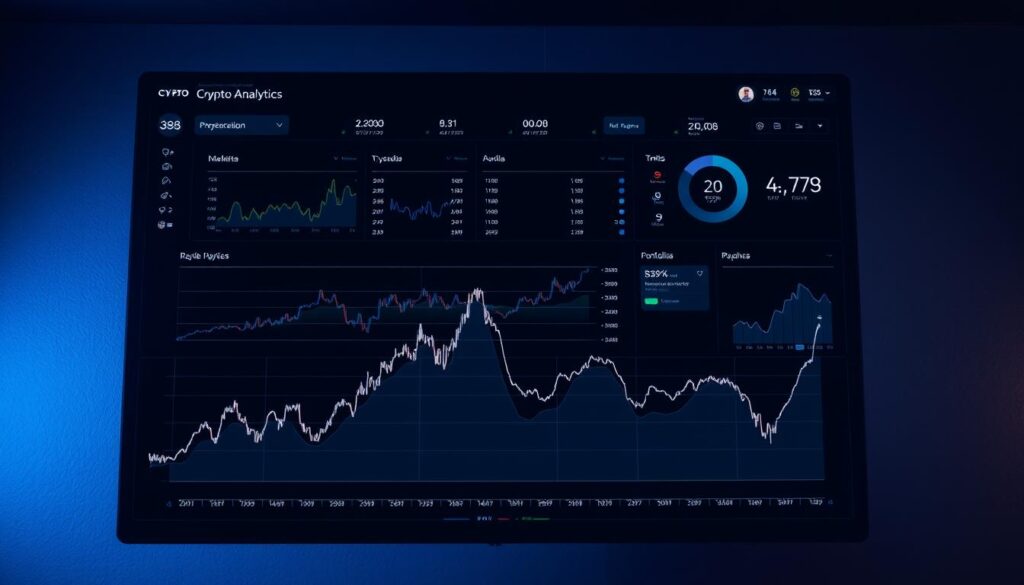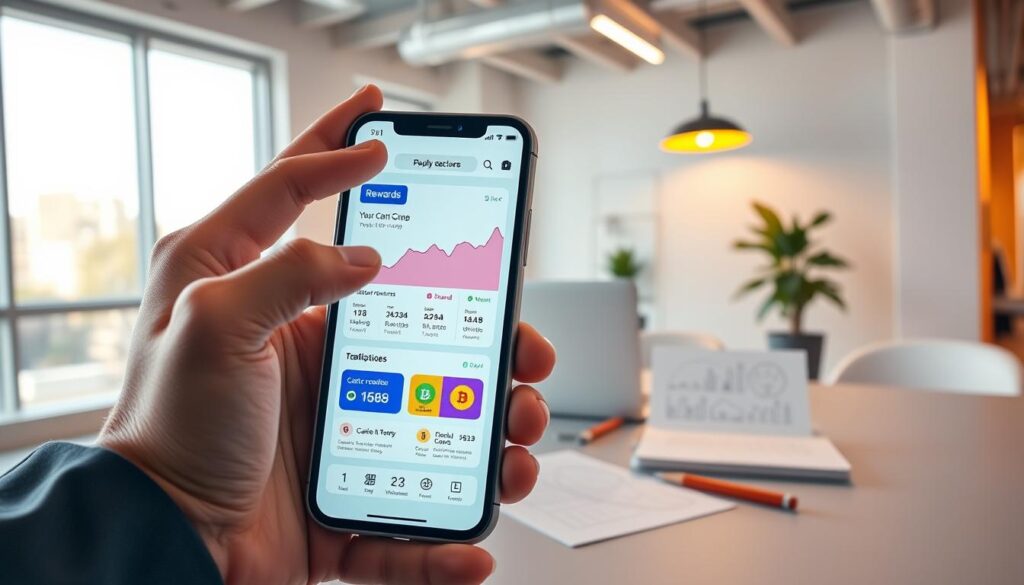Now Reading: Top Crypto Portfolio Trackers to Manage Your Investments
- 01
Top Crypto Portfolio Trackers to Manage Your Investments
Top Crypto Portfolio Trackers to Manage Your Investments
The cryptocurrency market has grown fast, making it key for investors to use good tools. With over $1.5 trillion in global crypto assets, keeping track of Bitcoin, Ethereum, and others is hard. Top crypto portfolio trackers help by giving real-time updates, performance stats, and tax info.
Investors struggle with data from places like Coinbase and Binance. They also have to do tax calculations by hand. But, crypto portfolio management tools bring all this data together in one place. This saves time and cuts down on mistakes.
These tools also send alerts for price changes and market trends. This helps users make fast decisions.
Readers will find out which top crypto portfolio trackers are the best. They’ll learn about their special features and how to pick the right one. Knowing about these tools helps investors make better choices and improve their strategies.
Key Takeaways
- Top crypto portfolio trackers centralize data from multiple exchanges and wallets.
- Real-time analytics and tax tools reduce manual effort and errors.
- Features like API integration and mobile apps enhance accessibility.
- Choosing the right tracker improves decision-making and profitability.
- Comparisons between free and premium tools are analyzed for all investor types.
Understanding Cryptocurrency Portfolio Management
Managing digital assets today is more than just tracking prices. Early investors used spreadsheets or basic apps. Now, cryptocurrency portfolio management tools offer advanced features for crypto’s unique volatility. Platforms like Nansen, Debank, and Zerion lead the way, combining analytics with insights.
The Evolution of Digital Asset Tracking
The journey from manual spreadsheets to AI-driven dashboards shows crypto’s growth. Early users tracked Bitcoin prices with simple tools. But, DeFi and NFTs brought the need for advanced solutions. Today’s top digital asset tracking platforms offer multi-chain support, tax tools, and risk analysis. They make complex portfolios easier to manage.
Why Monitoring Your Crypto Investments Matters
Crypto markets are highly volatile, requiring constant attention. Unlike stocks, crypto lacks traditional safeguards. So, real-time monitoring is crucial. Tools like CoinTracker alert users to price dips or network risks, helping avoid losses.
Regular checks also reveal opportunities in decentralized protocols or yield farming.
The Role of Real-time Data in Investment Decisions
Delays in data can cost investors. For example, a 10-minute delay during a flash crash might mean missing a sell signal. Leading platforms provide instant updates, allowing traders to act quickly.
Features like live charts and price alerts turn raw data into strategies. They help investors stay ahead of market trends.
Key Benefits of Using Dedicated Crypto Tracking Software
Investors using top crypto portfolio trackers get special tools for managing digital assets. These platforms make it easy to track assets across different exchanges and wallets. They offer features like gas fee analysis and monitoring of blockchain transactions.
Unlike regular finance apps, crypto-specific software collects data automatically. This cuts down on manual errors and saves time spent on reconciling spreadsheets.
- Real-time updates help users act fast on price changes and network issues.
- Automated checks spot any missing transactions, preventing losses.
- Visual dashboards show how your portfolio stacks up against market benchmarks, pointing out weak spots.
Popular crypto portfolio monitoring software also makes tax reporting easier. It compiles transaction histories and cost basis calculations. This reduces the risk of audits and makes year-end filings simpler.
Users get insights to make better decisions, like spotting risky coins or underperforming DeFi projects. These tools offer clarity in a complex crypto world. By centralizing data, investors can focus on growing their portfolio instead of just tracking it.
Essential Features to Look for in Top Crypto Portfolio Trackers
When picking the best top crypto portfolio management tools, look for features that make tracking and decision-making easier. The best crypto apps offer a mix of functionality and ease of use. This meets the needs of all investors. Let’s explore what’s most important.
Multi-Exchange Support and API Integration
Platforms like CoinTracker and CoinStats connect to big exchanges through secure APIs. This means no more manual data entry. You get updates in real-time without sharing your private keys. APIs also keep balances up to date across platforms like Binance or Coinbase, cutting down on mistakes.
Mobile Accessibility and Cross-Platform Sync
Apps like FTX Portfolio Tracker focus on mobile use. They send alerts for price changes or trade chances. Data syncs smoothly between iOS, Android, and desktop, giving you insights wherever you are.
Performance Analytics and Visualization
Tools like Delta use charts and heatmaps to show how assets relate and risk levels. You can track ROI, volatility, and diversification ratios. Custom dashboards let you see trends with interactive graphs.
Tax Calculation and Reporting
CoinTracker has automated tax features that figure out capital gains/losses and make IRS reports. CoinStats even suggests tax-loss harvesting. You can export PDFs for easy filing with accountants, avoiding audit worries.
CoinTracker: Comprehensive Portfolio Management Solution
CoinTracker is a top pick among recommended crypto investment trackers. It was founded in 2017 and now supports over 200 exchanges and 10,000+ assets. This makes it a leading choice for tracking cryptocurrency portfolios.
This tool makes managing complex portfolios easier. It uses advanced automation and focuses on compliance.
![]()
Standout Features and Functionality
- Automated tax reporting for 50+ countries with IRS-compliant exports
- Real-time price alerts and historical performance charts
- Support for DeFi staking rewards and NFT tracking
- Pro tier includes tax-loss harvesting recommendations
It supports multiple blockchains, including Ethereum and Solana. This ensures you can see your holdings clearly.
Pricing Structure and Subscription Options
- Free Tier: Tracks up to 100 assets with basic analytics
- Pro ($9.99/month): Unlimited assets, advanced charts, and tax reports
- Premium ($29.99/month): Includes professional tax templates and API access
Annual subscriptions save 15%. Free users can’t export all historical data.
User Experience and Interface Navigation
The dashboard is customizable and has dark/light mode. Mobile app users like the easy coin comparison tools. But, some charts are better on desktop.
Customer support is available via live chat and email. They usually respond within 2 hours when it’s busy.
Setting up CoinTracker is easy, but importing old transactions can take time. It’s designed to be easy to use but still professional.
FTX (formerly Blockfolio): Mobile-First Tracking Experience
FTX’s crypto portfolio tracker, once Blockfolio, is now a top best crypto app for hands-on investors. It focuses on mobile use, making it a key player among leading cryptocurrency portfolio tracking apps. The app started simple but now includes FTX’s tools without losing its clean look.
- Coin Coverage: Tracks over 5,000 cryptocurrencies, supporting major exchanges and wallets.
- Alerts & News: Real-time price alerts and a curated news feed for market updates.
- Trading Access: Direct links to FTX exchange for quick trades, though third-party integrations are limited.
The app is free to use, perfect for casual traders who value being on the move. Premium features, like advanced analytics, need a FTX account. While easy to use, it lacks customization for complex portfolios. Recent issues with FTX have raised questions about its reliability, but it still works well for quick tracking.
As a leading cryptocurrency portfolio tracking apps, FTX offers convenience and speed. However, advanced users might need more tools for detailed tracking.
CoinStats: Balancing Simplicity and Advanced Features
CoinStats is a top choice for popular crypto portfolio monitoring software and top blockchain portfolio trackers. It offers a simple design with deep analysis tools. This makes it perfect for those who want ease without losing out on detail.
Real-time Synchronization Across Devices
CoinStats uses cloud tech for real-time synchronization on iOS, Android, and desktop. When prices change or trades happen, all devices update at once. Even without internet, users can still see their portfolios. They sync up as soon as they get back online.
News Integration and Market Insights
It has news from 50+ sources like CoinDesk and Cointelegraph. Users can set alerts for their favorite coins. Premium users get tools to analyze market sentiment, showing trends for their coins.
Community Features and Social Trading Elements
- Follow top traders’ portfolios to track strategies
- Join community groups for market discussions
- Premium users access copy-trading tools to replicate trades automatically
Free users can share news, while paid plans offer more social features. Unlike some top blockchain portfolio trackers, CoinStats keeps its social features simple. But, it doesn’t track DeFi assets as well as Delta does.
For investors who want it easy but also want to dive deep, CoinStats is a good choice. It combines social features with useful market data, making it stand out among popular crypto portfolio monitoring software.
Delta: Design-Focused Portfolio Management
Delta is a top choice among top crypto portfolio trackers for its focus on design and function. Its interface is easy to use and lets you customize your dashboard. You get to see your portfolio in interactive charts and with color-coded breakdowns.
Users can switch between 2D and 3D views to quickly understand market changes.
Connecting to exchanges and wallets is easy with support for over 200 platforms. It’s all secure with 2FA and end-to-end encryption. Delta also sends price alerts and lets you track up to 500 assets.
Pro-tier users get extra tools like volatility metrics and portfolio rebalancing.
- Customizable 3D portfolio visualizations
- Real-time price alerts with customizable thresholds
- Pro-tier access to advanced risk assessment models
- 2FA-protected API connections for major exchanges
Delta’s design is simple, but it might not offer as much data as CoinTracker. It’s great for beginners who like easy-to-use tools. For more advanced users, there are pro features for making smart choices.
Pricing starts at $9.99/month. It’s a good balance between free options and more advanced cryptocurrency portfolio management tools. It’s perfect for those who value good looks without giving up on essential tracking features.
Top Crypto Portfolio Trackers for Advanced Traders
For advanced traders, the top digital asset tracking platforms focus on accuracy and growth. These recommended crypto investment trackers offer tools for big portfolios. They help in making smart, data-based decisions.
Institutional-Grade Analytics Platforms
Lukka, Messari Pro, and CoinMetrics offer top analytics for big players. They have:
- Correlation matrices to show how markets connect
- Risk-adjusted return metrics for better portfolio management
- Liquidity analysis to see how trades affect prices
They also have tools to predict price changes in big trades. Prices start at $2,000/month. You need API keys and coding skills to use them.

API Trading Integration Capabilities
Platforms like 3Commas and dYdX let you connect directly via API. This means you can:
- Test strategies with past data
- Automatically adjust your portfolio across exchanges
- Make trades directly with API keys
They keep your data safe with extra security steps. You might need to know Python or JavaScript to use them fully.
Custom Alert Systems and Notification Features
Nomics and Bybit have alerts that go beyond just price changes. They include:
- Alerts based on multiple conditions (price, volume, volatility)
- Watching smart contract events for DeFi positions
- Alerts for market manipulation
Setting these up takes some work but saves time. Getting started right is key, with help from training and support.
Free vs. Premium Tracking Solutions: What You Get
When picking between free and paid crypto tracking tools, think about your investment goals. Free options give you the basics, but best crypto apps like Blockfolio’s free version might not have all you need. You might miss out on tracking transactions, getting updates fast, and connecting with exchanges.
Tax tools and deep analytics are usually for those who pay more. This means you might have to track your investments by hand.
Limitations of Free Portfolio Trackers
- Transaction caps: Free tiers may restrict tracking to 10-20 assets
- No tax reports: Manual calculations required for IRS filings
- Delayed data: Updates can lag behind premium real-time feeds
When to Upgrade to Paid Subscriptions
Investors with big portfolios, over $10k, might want to pay for better tools. Paid plans offer:
- Enterprise-grade analytics from top crypto portfolio management tools like Delta
- Customizable alerts for volatile markets
- Year-round tax reporting starting at $9.99/month
Paid options range from $5 to $50 a month. They’re worth it for traders who need API access or top-notch security.
Value Assessment for Investor Types
Casual investors might be okay with free versions. But, active traders will find more value in CoinStats’ detailed charts. For pros, CoinTracker’s API integrations are key.
For those who only need certain features at certain times, like during tax season, there are options. Delta’s starter plan is a good middle ground at $10 a month.
Security Considerations When Choosing Tracking Software
Choosing the right crypto portfolio tracker is key. It’s about finding a balance between ease and safety. Popular trackers handle sensitive info, so strong security is a must.
Start by looking at platforms that limit API access. The best ones give out view-only API keys to stop unauthorized trades. Always be careful with permissions to lower risks.
Seek out tools with two-factor authentication (2FA) and end-to-end encryption. Third-party security audits boost trust. Make sure the platform’s privacy policy doesn’t share your data with advertisers.
Reputable services like CoinTracker or Delta explain their encryption and how they handle security issues.
- Use view-only API keys for exchanges
- Enable 2FA for all accounts
- Check encryption standards (e.g., AES-256)
- Monitor platform security histories for past breaches
Don’t use the same password everywhere. If something seems off, change or revoke API keys. Choose apps that are clear about how they handle your data. This way, you can keep your investments safe while still using the software easily.
How to Set Up Your First Crypto Portfolio Tracker
Starting with crypto portfolio tools is straightforward. Follow these steps to manage your crypto investments well.
Creating Your Account and Security Settings
- Choose a platform like leading cryptocurrency portfolio tracking apps such as CoinTracker or CoinStats.
- Set a strong password and enable two-factor authentication (2FA) during registration.
- Adjust privacy settings to control data visibility and enable recovery options like email verification or security questions.
Backup recovery codes in a secure offline locationto protect against account loss.
Connecting Exchanges and Wallets
To sync assets:
- Access the “Connections” section in your chosen tool.
- Generate API keys with view-only permissions from exchanges like Binance or Coinbase.
- Input API keys carefully to avoid granting trading access accidentally.
If errors occur, check API permissions or regenerate keys for security.
Importing Historical Transaction Data
Transfer past transactions via:
- CSV file uploads for bulk data
- Manual entry for small datasets
- Third-party integrations like blockchain explorers
Verify totals match exchange records to ensure accuracy.
Customizing Dashboard and Alerts
Optimize your experience by:
- Setting price alerts for specific coins
- Choosing pie charts or graphs for asset allocation views
- Activating mobile push notifications for real-time updates
Tools like CoinStats let you tailor alerts to market movements, while Delta offers advanced visualization options.
Tax Implications and How Trackers Can Help
Cryptocurrency investments are subject to strict U.S. tax rules. The IRS views crypto as property, requiring the reporting of capital gains. This includes trades, mining, staking, and NFT sales. Short-term gains are taxed at a higher rate than long-term ones.
Top crypto portfolio management tools make compliance easier. They automate tasks like calculating capital gains and tracking cost bases. They also flag taxable events and generate IRS forms.
![]()
Yet, manual review is still essential for unique cases. This includes tax-loss harvesting or overseas transactions. Year-round updates are key to accuracy, as waiting until April can lead to missed data.
While these tools are helpful, consulting a crypto-savvy accountant is crucial. They offer foundational support but never replace professional tax advice for complex situations.
Common Challenges and Troubleshooting Tips
Using top blockchain portfolio trackers can sometimes run into problems. This guide will help you solve common issues. It aims to keep your tracking accurate and smooth.
Dealing with Missing Transactions
Missing transactions can mess up your balance. Here’s what to do:
- Check your API connections to exchanges in the tracker’s settings.
- Use the platform’s transaction log to add missing entries manually.
- Look out for duplicate entries from delayed API updates.
For transfers not on exchanges, use blockchain explorers like Etherscan to check activity.
Resolving Synchronization Issues
Synchronization problems can cause outdated prices or slow updates. Try these steps:
- Update API keys in platform settings for exchanges like Binance or Coinbase.
- Clear cache data in the tracker’s advanced options.
- Reinstall the app or browser extension for mobile/desktop sync issues.
Issues like “API connection failed” might fix by switching servers or contacting top digital asset tracking platforms support.
Managing DeFi and NFT Assets
Traditional trackers have trouble with DeFi and NFTs. For DeFi:
- Use Zerion or NFT Portfolio to track yield farming and staking rewards.
- Enter DeFi positions manually into CoinTracker or Blockfolio.
NFTs need special tools like OpenSea’s integration or third-party platforms. Connect these with your main tracker for a complete view.
Emerging Trends in Cryptocurrency Portfolio Management
New technologies are changing how we watch our crypto investments. Popular crypto portfolio monitoring software now use artificial intelligence. This AI predicts price changes and helps pick the right assets.
Machine learning looks at past data to suggest trades. It also spots chances in real-time. Now, best crypto apps like Delta and CoinStats have AI dashboards. These give users important insights.
Decentralized finance (DeFi) brings new challenges. Platforms must track liquidity pools and cross-chain assets. New tools like on-chain analytics let users see whale activity or smart contract interactions.
Tools like Nansen show real-time network data. They combine this with portfolio views. Privacy features like zero-knowledge proofs keep your investments safe without showing them.
- Social trading: Copy-trading lets users follow top traders’ moves.
- Regulatory compliance: Apps now handle tax reports for global rules.
- Hybrid portfolios: Some platforms link crypto with stocks and real estate for a full view.
These updates aim to make things simpler. Users get tools to manage risk, automate taxes, and see trends with interactive charts. Even though some features are still in beta, experts think they’ll be widely used by 2024. Choosing the right best crypto apps is key to keeping up with the market.
Comparing Desktop, Mobile, and Web-Based Tracking Solutions
Choosing between desktop, mobile, or web-based tools depends on balancing usability and functionality. Leading cryptocurrency portfolio tracking apps often tailor features to their delivery method. This shapes how investors access and manage data.
Accessibility vs. Feature Depth
Mobile best crypto apps like Blockfolio focus on speed and portability. They may lack advanced analytics. Desktop platforms such as CoinTracker offer detailed charts and API links but need a computer.
Web-based solutions like CoinStats aim for a middle ground. They simplify some functions for cross-browser compatibility.
- Mobile: Quick updates but limited customization
- Desktop: Full feature sets but fixed location
- Web: Accessible anywhere but may lack offline tools
Performance Considerations
Desktop apps handle real-time price feeds and complex calculations faster. Mobile counterparts are slower. Web platforms refresh data instantly but need internet access.
Battery-heavy tasks like backtesting strategies work best on PCs. Mobile apps excel in push alerts for price drops.
Integration Capabilities
Desktop tools integrate well with tax software like TurboTax and hardware wallets. Mobile apps often limit API access to basic export formats. Web apps offer browser extensions and cloud sync, though compatibility varies.
Investors with large portfolios needing DeFi tracking may favor desktop. Casual users might prefer mobile apps for updates. Web-based options suit those valuing flexibility over advanced functions.
Making the Most of Your Crypto Investment Journey with the Right Tracking Tools
Choosing the right crypto portfolio tracker depends on your investment style and goals. The trackers reviewed offer various features, like tax tools and real-time analytics. First, think about your portfolio’s complexity, how often you trade, and your security needs.
Beginners might want simple tools, while advanced traders need customizable alerts and API integrations. Consider how often you want updates and if tax reporting is important. Tools like CoinTracker make year-end compliance easier, and CoinStats’ sync across devices is handy.
Regularly reviewing your portfolio helps spot underperforming assets. Setting alerts for price changes can also prevent missed opportunities. Start with free tiers to test features before upgrading to paid plans.
As your investments grow, you might need to change your tracking strategy. DeFi and NFT integration becomes key as markets change. Top trackers update their features to keep up with trends, so stay informed about updates.
Good tracking tools turn data into useful insights, helping you make better choices. By choosing tools that fit your evolving needs and offer features like tax optimization, you can confidently navigate market changes. Make sure your tools are secure and scalable for long-term success in the crypto world.
FAQ
What are the top crypto portfolio trackers available today?
Top crypto portfolio trackers include apps like CoinTracker, Blockfolio (FTX), and Delta. They offer features like multi-exchange support and real-time data. These tools are key for managing your cryptocurrency portfolio.
Why is it important to use a dedicated cryptocurrency portfolio management tool?
A dedicated tool improves tracking accuracy and efficiency. It’s designed for digital assets, allowing you to track performance and manage wallets. It also gives insights for better investment decisions.
How do portfolio trackers enhance risk management?
Portfolio trackers help investors monitor market trends and spot risks. They allow for portfolio rebalancing based on performance. This helps manage market volatility effectively.
Can I track decentralized finance (DeFi) assets with portfolio trackers?
Yes, many tools now support DeFi assets. They track liquidity pools and yield farming positions. This gives a full view of your crypto holdings.
What features should I look for in the best crypto apps?
Look for multi-exchange support, API integration, and performance analytics. Mobile accessibility and tax calculation capabilities are also important. These features enhance user experience and asset management.
Are there any free cryptocurrency portfolio tracking solutions?
Yes, tools like CoinStats and Blockfolio offer free versions. However, free versions have limitations. Paid options offer more features for serious investors.
How can portfolio trackers assist with cryptocurrency tax compliance?
Many tools help with tax compliance, including capital gains calculations. They track transaction history and generate tax forms. This streamlines tax reporting and manages tax implications.
What are the main security concerns when using crypto portfolio trackers?
Security concerns include data breaches and API vulnerabilities. Choose platforms with strong security, like two-factor authentication and encryption. Regular security audits are also important.
How can I optimize my use of crypto tracking tools?
Regularly review your portfolio and use alert systems for price changes. Leverage tax optimization features and keep accurate records. This ensures effective investment management.














